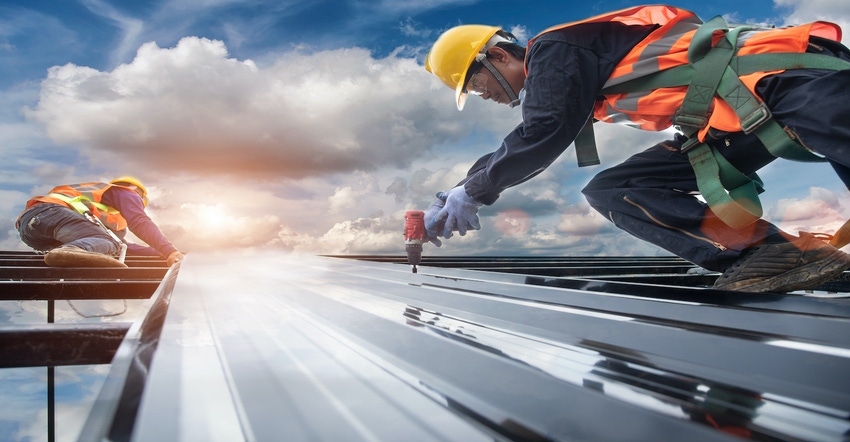Metal roofing manufacturers and suppliers have largely gotten past supply chain issues that still plague much of the industry, but hurdles to growth still remain.
April 12, 2022

As roofers struggle with labor and supply issues, at least one sector of the industry appears to have dodged much of that pain—residential metal re-roofing installers.
“Speaking with industry contacts and installers, they have been busier than heck,” according to Renee Ramey, executive director of the Metal Roofing Alliance. “From what I’m hearing it could be a record-performing year.”
Todd Meinhold, owner and president of H&D Quality Builders, Inc. and Cool Roofs, agreed with that assessment. “Our metal roof back log of six months has been consistent for 10 years, with 2022 being even stronger,” he said.
Ramey added that metal roofing manufacturers and suppliers have largely gotten past supply chain issues that still plague much of the industry and are now back to a normal turnaround on products and supplies. “As COVID has subsided and companies have figured out how to get the supply chain up and running again we’ve seen supply chain issues go away for the most part,” she said.
Still, some products are only available in small quantities, and “some products are simply unavailable for the foreseeable future,” said Stefan L. Boyer Owner/ Sales & Marketing Manager for Metal Roofing HeadQuarters.
The metal roofing sector is still waiting for 2021 numbers, but Ramey is confident that they’ll equal or better 2020. That would be quite a feat, since 2020 set records, according to that year’s Dodge Report, which measures overall roofing demand and activity on an annual basis. The report showed that in 2020 the share of metal roofing used for residential re-roofing in the U.S. rose from 12 percent in 2019 to 15 percent.
“We’re quite happy with a 2- to 3-percent market increase,” Ramey said. “Based on what I’m hearing, I would like to hope we’re getting to that 17- to 18-percent mark."
The reasons for those rising numbers are revealed in the Dodge Report:
… While traditional metal roofing styles such as standing seam remain popular, homeowners also are gravitating to the wide variety of designs that metal roofing offers, including shingle, shake, tile and slate. Steel remains the most common type of metal roofing for re-roofing projects, due in part to its affordability and strength. Like other metal alloys, steel also increases energy efficiency and can be 100 percent recycled at the end of its long life, making it a sustainable and better performing choice for even the harshest climate conditions, including high winds and hail, heavy snow and ice loads.
Importantly, the adoption of metal roofing rose in regions that suffered severe impacts from climate extremes in recent years, including the Mountain and Atlantic areas. Hurricanes and wildfires have intensified in those regions and affected more homeowners, causing them to gravitate towards resilient and protective products that can help better safeguard their homes. Quality metal roofs, which carry the highest possible Class A fire rating and can withstand hurricane force winds, are an essential component in fortifying homes against the worst that Mother Nature can throw at them.
While not measured by the Dodge Report, the MRA also theorizes that homeowners are increasingly attracted to metal roofing’s low maintenance and easy-care benefits, based on the organization’s own data and web site that receives hundreds of thousands of visits from homeowners looking to learn more about metal roofing every year.
For all of those reasons the report identified, Ramey said roofers who aren’t offering metal roofing are missing an increasingly lucrative market. She added that margins are typically better with metal roofing, because customers are often professionals with dual incomes who are willing to spend more to get what they want. And because metal roofs cost about twice as much as traditional asphalt—but also last twice as long—that market is typically higher end, she added.
Ramey said one of the hurdles to growing the market more are roofers themselves who often are under some of the same common misconceptions about metal roofs as consumers including:
Style and color options are limited.
It’s not as energy efficient. It may make my home too hot in the summer.
It won’t perform as well in extreme conditions.
It’s not as sustainable as other materials.
It will be noisy.
It will be too heavy
Another common myth among roofers is that they’re too difficult to install. But Ramey said that just like asphalt roofing, installers can be trained through a number of programs including those from manufacturers. Such training usually takes about a week and most manufacturers offer free courses. Once trained, skilled installers can lay a roof in as a little as a day and a half.
“It’s not rocket science to install metal roofs,” she said. “There are just some nuances that you have to learn. But once you get those down, it’s actually quite quick to put down a roof.”
Read more about:
material shortagesAbout the Author(s)
You May Also Like




